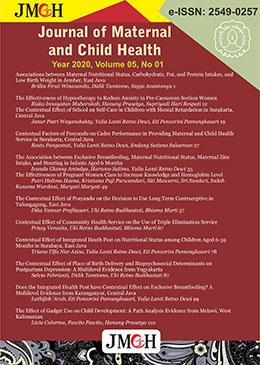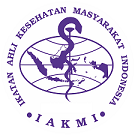The Contextual Effect of Place of Birth Delivery and Biopsychosocial Determinants on Postpartum Depression: A Multilevel Evidence from Yogyakarta
Abstract
Background: Postpartum depression is a condition that affects 20% women in the first four weeks of the puerperium. Postpartum depression can be affected by biological, psychological, socio-cultural, and economic factors. This study aimed to analyze biopsychosocial factors affecting postpartum depression in Sleman, Yogyakarta.
Subjects and Method: This was a cross-sectional study. This study was conducted at 25 delivery places in Sleman, Yogyakarta, in August-September 2019. A sample of 200 postpartum mothers was selected by multistage random sampling. The dependent variable was postpartum depression. The independent variables were traditional treatment, age, education, income, parity, pregnancy status, type of delivery, complication, marital satisfaction, and contextual delivery place. The data were collected by questionnaire and analyzed by a multilevel multiple logistic regression.
Results: The risk of postpartum depression increased with delivery with intervention (b= 3.30; 95% CI= 1.57 to 5.02; p<0.001), delivery with complication (b=3.77; 95% CI= 2.25 to 5.28; p<0.001), and age ?35 years (b=0.93; 95% CI=-0.20 to 2.07; p=0.109). The risk of postpartum depression decreased with traditional treatment (b= -1.33; 95% CI= -2.51 to -0.15; p= 0.027), education ?Senior high school (b=-1.98; 95% CI= -3.59 to -0.38; p=0.015), family income ?Rp 1,701,000 (b= -3.55; 95% CI= -5.08 to -2.02; p<0.001), multiparous (b= -1.25; 95% CI= -2.45 to -0.04; p=0.041), intended pregnancy status (b= -3.11; 95% CI= -4.96 to -1.25; p= 0.001), and happy marital satisfaction (b= -1.18; 95% CI= -2.30 to -0.05; p=
How to Cite
References
Abbasi S, Chuang CH, Dagher R, Zhu J, Kjerulff K (2013). Unintended pregnancy and postpartum depression among first-time mothers, J Women
Agarwala A, Arathi RP, Narayanan P (2018). Prevalence and predictors of postpartum depression among mothers in the rural areas of Udupi Taluk, Karnataka, India: A cross-sectional study
Aizar E (2018). Massage postpartum and fungtional status in postpartum mother in medan, Buletin farmatera. 3(1): 24
Bhusal BR, Bhandari N (2018). Identifying the factors associated with depressive symptoms among postpartum mothers in Kathmandu, Nepal, International Journal of Nursing Sciences. 5(3): 268
Demirel G, Egri G, Yesildag B, Doganer A (2018). Effects of traditional practices in the postpartum period on post-partum depression, Health Care for Women International. 39(1): 65
Gelaye B, Rondon M, Araya R, Williams MA (2016). Epidemiology of maternal depression, risk factors, and child outcomes in low-income and middle-income countries, The Lancet Psychiatry. 3(10): 973982. doi: 10.1016/s2215-0366(16)30284-x [Crossref] [Google Scholar]
Dinas Kesehatan Kabupaten Sleman (2018). Profil Kesehatan Kabupaten Sleman Tahun 2018, Sleman. Dinas Kesehatan Kabupaten Sleman. [Website]
Fitriana WD, Banun S, Istiqomah T, Ersam T, Fatmawati S (2018). The relationship of secondary metabolites: A study of Indonesian traditional herbal medicine (Jamu) for post-partum maternal care use, AIP Conference Proceedings 2049, 020096, 1-8. doi: 10.1063/1.5082501 [Crossref] [PubMed] [Google Scholar]
Gelaye B, Rondon M, Araya R, Williams MA (2016). Epidemiology of maternal depression, risk factors, and child out-comes in low-income and middle-in-come countries, Lancet Psychiatry. 3(10): 973
Gebuza G, Kazmierczak M, Malgorzata MM, Banaszkiewicz (2016). Adequacy of social support and satisfaction with life during childbirth, Ann Transplant. 22(2): 135-140. doi: 10.1016/j.poamed.2016.01.004 [Crossref] [Google Scholar]
Gupta S, Kishore J, Mala YM, Ramji S, Aggarwala R (2013). Postpartum depression in North Indian women: Prevalence and risk factors, J Obstet Gynaecol India. 63(4): 223
Hackley B, Sharma C, Kedzior A, Sreenivasan S (2010). Managing mental health conditions in primary care settings, J Midwifery Women
Hahnholbrook J (2018). Economic and health predictors of national post-partum depression prevalence: A systematic review, meta-analysis, and meta-regression of 291 studies from 56 countries, Front psychiatri. 8 (248): 1
Mart
Idaiani S, Basuki B (2012). Postpartum depression in Indonesia women: A national study, HSJI. 3(6): 3
Jamal JA, Ghafar ZA, Husain K (2011). Medicinal Plants used for postnatal care in malay traditional medicine in the peninsular Malaysia, J Pharmacogn phytochem. 3(24): 15
Jannah AM, Budihastuti UR, Murti B (2019). Contextual Effect of Place 0f Birth Delivery on Depression in Karanganyar, Central Java, J Matern Child Health. 4(3): 212
Kim Y, Dee V (2018). Sociodemographic and obstetric factors related to symptoms of postpartum depression in hispanic women in rural California, J Obstet Gynecol Neonatal Nurs. 47(1): 23
Kirpinar I, G
Mariyati, Tumansery GS (2018). Perawatan diri berbasis budaya selama masa nifas pada ibu postpartum, Jurnal Ilmu Keperawatan. 6(1): 47-56. [Website]
Nurbaeti I, Deoisres W, Hengudomsub P (2019). Association between psychosocial factors and postpartum depression in South Jakarta, Indonesia, BMJ Sex reprod health. 20: 72
Nugroho T, Nurrezki, Warnaliza D, Wilis (2014). Buku ajar asuhan kebidanan nifas, Nuha Medika, Yogyakarta.
Pham D, Cormick G, Amyx MM, Gibbons L, Doty M, Brown A, Beliz
Putriarsih R, Budihastuti UR, Murti B (2017). Prevalence and determinants of postpartum depression in Sukoharjo District, Central Java, J Matern Child Health. 03(01): 395
Rahayu DT (2018). Pendidikan komunitas tentang pemakaian bengkung pada ibu nifas di desa Keling Kecamatan Kepung Kabupaten Kediri. At-Tamkin, Jurnal Pengabdian kepada Masyarakat. 1 (1): 35-44. [Website]
Ria MB, Budihastuti UR, Sudiyanto A (2018). Risk Factors of postpartum depression at Dr. Moewardi Hospital, Surakarta, J Matern Child Health, 3(1): 81
Riskesdas (2018), Hasil Utama Riset Kesehatan Dasar Tahun 2018. Kementerian Kesehatan Badan Penelitian dan Pengembangan Kesehatan. [Website]
Turkcapar AF, Kadio?lu N, Aslan E, Tunc S, Zayifo?lu M, Mollamahmuto?lu L (2015). Sociodemographic and clinical features of postpartum depression among Turkish women: A prospective study, BMC Pregnancy and Childbirth. 15(1): 1
Wahyuni (2014). Faktor internal dan eksternal yang mempengaruhi depresi postpartum. Jurnal terpadu ilmu kesehatan, 3(2): 106
Wang Y, Wang YJ, Wang H, RuZhang Y, Jian Ma L, Wang MZ, Yuan SX (2017). Living with parents or with parents-in-law and postpartum depression: A preliminary investigation in China, J Affect Disord. 218: 335
Xu H, Ding Y, Ma Y, Xin X, Zhang D (2017) Cesarean section and risk of post-partum depression: A meta-analysis, J Psychosom Res. 97: 118
Youn HC, Lee S, Han SW, Kim LY, Lee TS, Oh MJ, Cho GJ (2017). Obstetric risk factors for depression during the post-partum period in South Korea: A nationwide study, J Psychosom Res. 102(6): 15










